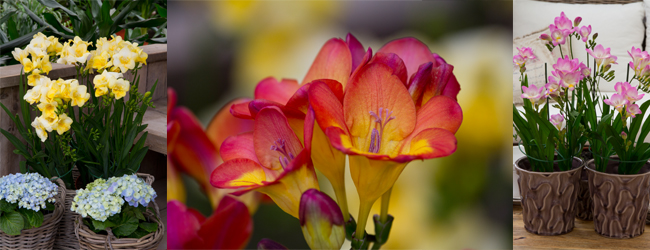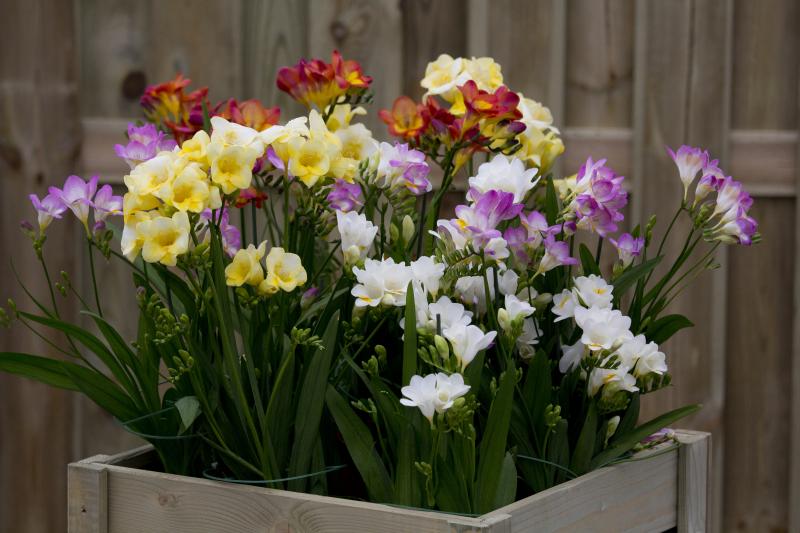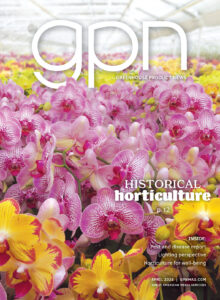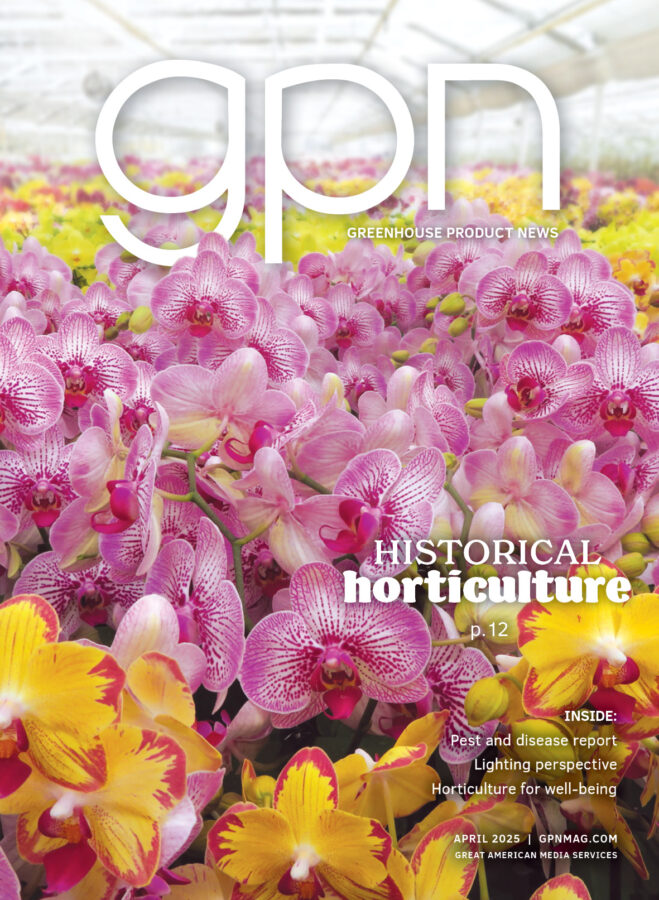
Freesia: Simplicity is the Ultimate Source of Sophistication

In today's ever-changing gardening world, it is easy for a grower to become overwhelmed with choices. Many of these choices are combinations — hanging baskets, patio containers and the list goes on and on.
This is why it is important to remember the simplicity of a single planting.
One of these such plants is freesia. With its graceful stems, the freesia stands alone as a flower with elegance, style and sophistication. This fragrant plant is ideal for both indoor and outdoor use.
History and Evolution
Discovered in South Africa, the freesia was relatively unknown until the 1970s when breeders started working commercially with this crop. Work has continued to the present day to further improve the freesia assortment.
One such company, Van den Bos, located in Holland, has been breeding freesia for almost half a century. Following the introduction of the first varieties in the mid 1970s, they have since created many new colors and varieties resulting in a brand new assortment.
Van den Bos breeder Daan Vermeer has helped develop the modern freesia by focusing on disease resistance and compact varieties. Newer varieties feature bicolors and double flowers. He has also made significant progress in fusarium resistance.
Vermeer states, "Today's grower wants fragrant plants with a variety of colors and sizes. At Van den Bos, our focus is to combine these needs with excellent disease resistance."

Freesia Growing Tips
When growing freesia, it is important to plant the corms within a few days of arrival. Before planting, dip the corms in a fungicide for approximately 15-20 minutes and then plant immediately.
When planting, it is important to plant deep enough. In a standard gallon pot, place the corms half way down the pot so there is about 3-4 inches of dirt on top of the corm. With a standard 6-inch pot, it is recommended to plant close to the bottom of the pot. The corms should be placed in the pot with the tips/sprouts up and the thicker portion of the corm down. When planting, it is suggested to place in pots evenly. Water immediately after planting.
Most freesia is delivered as a 5/6 corm. Suggested plantings are as follows:
Three plants per 4- to 5-inch pot
Five plants per 6-inch pot
Seven plants per 1-gallon pot
Seven to nine plants per 8-inch pot
After the initial watering, let the corms root. They typically will not need additional watering until you see 1/2-1 inch of the roots and also some sprout development. Freesias produce many roots that will actually pull the corm a bit deeper in the soil. It is important to keep the roots moist but do not overwater.
Once plants have been established, water the crop only when the top soil is starting to get lighter in color. Improper watering will cause stress of the plant.
Important to note: freesias are extremely sensitive to fluoride. Fluoride may be found in irrigation water and slow release fertilizer. Do not use super phosphate as fluoride is an ingredient. Higher fluoride levels in combination with higher temperature and low humidity can cause damage to the plant. Damage will start on the tip of the leaf and work itself toward the middle. Make sure to maintain EC levels below 1.0 and pH at 6.5-7.0.

Freesia is a cool-weather crop and needs a lot of ventilation. After planting, temperature range should be 50-70¡ F days and 40-55¡ F nights. Depending on location, you may be able to place pots immediately outside with no threat of deep freeze in forecast.
In California and southern states, freesias are generally grown outdoors. The cooler temperatures ensure the plant is working on initiating a flower as well as a more compact plant.
If growing in a cooler climate, it is suggested to place in a greenhouse or hoop house and keep above freezing. Allow the daytime temperature to increase a bit more and ventilate.
Proper ventilation is important for freesia crops. A structure with open sides or a well-vented greenhouse is ideal. Without this, Botrytis may be an issue.
Freesia require 4,000-6,000 foot-candles of light. This will help with compactness of plant.
For the northern climates, it is best to plant no earlier than late January. Also, it is suggested to not place pots under hanging baskets in the greenhouse. It can cause stretching of leaves and stems.
The most common pests include thrips and aphids. Thrips do not do much damage to foliage, but will attach to flower spikes and produce visible damage. Aphids can cause flower deformation; it is suggested to start preventative application prior to flowers becoming visible.

 Freesia is suitable for both indoor and outdoor applications.
Freesia is suitable for both indoor and outdoor applications.
Once you see color on the first blooms, plants are ready to ship. Freesia blooms open quickly from that point, usually three to five days. The second and third flowers will soon follow. A pot with multiple flowers may last upwards of five weeks.
The flowers are sensitive to ethylene and are suggested to ship with Ethyl/Bloc to maintain low levels.
Typical varieties such as the Main Streeet collection require 13-15 weeks grow time. More compact varieties offered by Van den Bos grow in nine to 11 weeks.
Staggered plantings work well for freesias, with the ideal season being February through June.
It's hard to tell what is most coveted about freesia plants: the way they look, or the way they smell. Freesia plants are visually stunning — they bloom in abundant clusters on gently arching stalks in a wide range of colors, including yellow, white, lavender, red, pink and fuchsia. Their sweet scent is extremely fragrant and popular.
Whether you seek its beauty or scent, the freesia offers something for everyone. The corms are available from Van den Bos' North American affiliate, Flamingo Holland.
 Many of today's freesia varieties feature exciting bicolored flowers.
Many of today's freesia varieties feature exciting bicolored flowers.
Freesia: Simplicity is the Ultimate Source of Sophistication









 Video Library
Video Library 


















